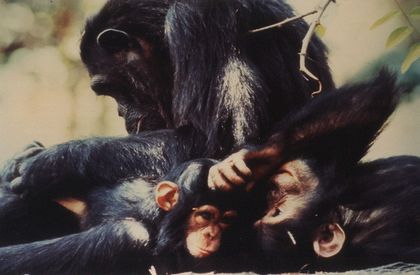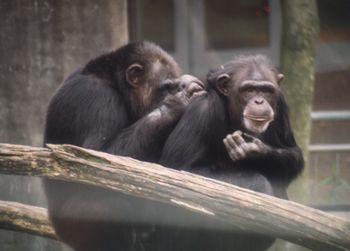Grooming

During times of
relaxation, a chimpanzee may often be found grooming
another chimpanzee or its own hair. The most obvious
function is the removal of pieces of debris from soil and
vegetation and dried skin from hair. The chimpanzee uses
one hand to hold the hair back while the other hand, lips,
or teeth are used to pick out and remove the small pieces
of debris.
Grooming is also used to
relax tension from threats and aggression. It helps to
maintain friendly ties among family and community members
and to lessen the stress of infants during weaning. A
chimpanzee may request or solicit grooming by approaching
another chimpanzee and getting their attention by
presenting a part of its body for grooming. It may scratch
itself or start to groom itself. Grooming is a very
important social and skin care behavior. A grooming
session may include several individuals of varying ages
and continue for a few seconds, minutes, or hours.
Captive Chimpanzees

Chimpanzees groom
themselves and each other in zoos in the same manner as
wild chimpanzees. Like wild chimpanzees, captive
chimpanzees find a number of places in their environment
to groom. Zoo chimpanzees often perform this comforting
and soothing behavior while sitting or lying high among
the tall support structures of their indoor habitats or
lying precariously on rock formations or in the grass out
doors. Likewise, wild chimpanzees choose to groom while
sitting in a grassy area, on rock formations or high in a
tree.
Mothers groom fussy
temperamental infants being weaned from nursing against
their wishes. Females relaxing outside on a hot day find a
shady spot to spend long periods of time grooming. On
occasion, it appears the entire social group is engaged in
a friendly, comforting social encounter grooming each
other.


